Kingston-upon-Hull (Hull), East Riding of Yorkshire
Up to 1834
In 1698, the Kingston-upon-Hull parishes of Holy Trinity and St Mary were incorporated under a local Act of Parliament (9 & 10 W.3. c.47) which gave them powers to manage their own poor relief and to set up a workhouse. A building known as Charity Hall was erected on Whitefriargate in 1698 although as a workhouse it proved 'almost useless' and until 1726 it was used as a training school and home for poor children rather than as a general workhouse. Amendments were made to the original Act in 1698 (11 W.3. c.18.), in 1708, and in 1741 (15 Geo.2. c.10). The first Governor was Alderman Robert Nettleton, a merchant, who married the only niece of the poet Andrew Marvell.
Charity Hall was the subject of a report in the second edition (1732) of An Account of Several Workhouses... dated April 17th, 1731, part of which is reproduced below.
By this Authority, a convenient House was then built, capable of receiving 170 or 180 people, called the Charity-Hall, and Money raised sufficient to defray the Charge thereof: But after this good Beginning, Part only of the Act being put in Execution, the Building proved almost useless, and the whole management often detrimental to the Poor. So that the House for many Years was no more than a Charity-School for Children, while the rest of the Poor were continued on their weekly Pensions. For the Act allowing no more Money to be raised, when the Poor increased, none could receive any Pension, but upon the Death of some other, whence it necessarily followed, that those who had the best Friends, got upon the List, while others who had the same Right, were forced to beg, and every Court had a great Number of Petitions which they could not answer.
THIS had been long lamented, and by some thought impossible to be remedied, but at last the major Part of the Corporation resolved to use the Method so much recommended by others, and to put the whole of the Act in Execution.
IN order whereunto, we got a Master from London, and allowed him 40l. per Annum Salary, at whose coming in January 1727-8. we set immediately about furnishing the House in the Manner which he directed, and in April, took off all Weekly Pay ; when few of them that had Pay came into the House, and most of them petitioned in vain against it ; The Number at first admitted were 101, which Number has since increased, and keeps fluctuating, sometimes over or under that Number.
THE Charge in fitting up the House was about 360l. which might have been defrayed by a Tax, but we chose rather to try by a voluntary Contribution, which was collected from House to House, the Week after Charity-Sermons had been preached by a neighbouring Clergyman at both our Churches, and by the Dissenters at both their Meeting Houses, and amounted to the Sum of 230l. This with the Stock we had before, and some Legacies we have received, defrayed the said Charge, and our Yearly Assessment, with some other Benefactions, supplied the House with Necessaries.
OUR Assessment, which is, no more than what it was 20 Years ago, (though the Town is much more populous) is so easy, that few can desire to have it lessened, the Richest paying not above a Shilling per Week ; and if the Event of two or three Years, shew that a little additional Charity will accomplish our Design, we doubt not but all our Brethren will Join their good Offices, to enable us to bring it to greater Perfection. And though our Poor's Rates should not be lessened, we hope to have few, or no Beggars in our Streets, and our Poor comfortably subsisted, so long as the Orders we have published shall be duly observed, which are as follows.
In 1728, the Corporation's management was overhauled and a new set of rules drawn up for running the workhouse.
I. THAT the Master take an Account of all Goods sent into the House, (the Time when, and by whom) in a proper Book, and keep the Tradesmen's Notes upon a File, receiving no Person into the House without an Order made at a General Court.
II. THAT he enter the Name of every Person so received, into a Register-Book, signifying, in proper Columns, the Times of their Admission and their Ages ; as also, their leaving the House, or their Deaths : That he search them carefully when they first come in, and strip them, or cause them to be stript to their Skin, so that such as are nasty may be well washed, new Clothes provided for them, their old ones baked in an Oven to destroy Vermin, well cleansed, and mended for the Use of the Owners, or others, as Occasion shall require : That he keep such as have the Itch, or other infectious Diseases, in proper Wards, till cured.
III. THAT he read, or cause to be read, such Prayers as the Guardian Ministers shall direct, every Morning before Breakfast, and every Evening before Supper, and whosoever shall be absent without Leave, shall lose that Meal ; That he cause Grace to be said by one of the Boys before and after each Meal; mind, that all who can be spared out of the House, go to Church, or some other Place of Religious Worship, twice every Lord's Day ; and that after Supper he cause to be read some Portion of Holy Scripture, or a Chapter in the Whole Duty of Man, or what the Guardian-Ministers shall appoint.
IV. THAT he cause all that are healthful and strong to rise in Summer at five or six, and in Winter at eight of the Clock, and go to Bed in Summer at nine, and in Winter at eight ; That he set all to Work at the usual Hours, and make the Children under six Years of Age go to School, and above six to work, learning to read or write once a Day ; and that he be present with them as often as possible to see they be so taught.
V. THAT he lay out with Prudence such Sums of Money as the Governor shall permit him to expend for the small incidental Necessaries of the Family, but in all other Cases employ such Persons to furnish the House as the Governor shall appoint, and acquaint him, if he finds any Imposition either in Price or Goodness ; That he cut and carve Meat for the Family, and see that the Nurses and others do their proper Business.
VI. THAT the Nurses get the Beds made by nine, and the Rooms swept and cleansed by ten of the Clock every Morning ; That they be washed in Summer twice every Week, and in Winter once at the least ; That they be aired every Day by opening the Windows as long as be thought proper ; That the Kitchen and Dining-Room be swept or washed every Day. That the Children be wash'd, comb'd and cleansed, so as to appear every Morning at School by seven or eight of the Clock.
VII. THAT if any Person go out of the House without the Master's Leave, or be disordered with strong Liquors ; if they steal, or remove with Intent to imbezzle any Goods, Money, or Clothes ; if they be heard to swear or curse, quarrel or scold ; if they pretend Sickness or Lameness, to be excused from Work, and be discovered by the Physician, or be guilty of any other Offence, they shall be punished by the Master, as the Committee shall direct.
VIII. THAT upon the Death of any Person in the House, the Nurse attending that Ward, shall immediately go for a Coffin to put the dead Corpse in, after washed, and with proper Assistance, shall remove it to the Place appointed for that purpose and shall deliver up to the Master all the Clothes, Money, or Goods belonging to the Deceased ; and if they neglect their Duty herein, they shall be, severely punished.
IX. THAT Notice be given by ringing a Bell, for the Family to come together to Breakfast, Dinner, and Supper, and that the Weekly Bill of Fare be as ordered by the Committee.
N. B. The Sick or Lame are not to be confined to the same Diet, but have such as shall be appointed by the Doctor.
Lastly, For Encouragement of Industry, it is ordered :
| That every Nurse be allowed, | 3d. | per Week. |
| Schoolmaster and Mistress each, | 3d. | |
| Spinning-Master, | 3d. | |
| Baker, | 4d. |
FOR Spinning and other Works, twopence in the Shilling out of the Money they earn, except they lay out the Money in strong Liquors, and get drunk, in which Case they hall be denied this Encouragement.
A parliamentary report of 1777 recorded Kingston upon Hull as having a workhouse able to accommodate 200 inmates.
An account written in 1897 (author unknown) describes the Hull workhouse and its operation a century earlier:
In front of the large central yard was a wall with large central gates, and at the end of such wall was a small doorway for when the central gates were closed. From Lady Day to Michaelmas, the summer period, the gates were open from 6 a.m. to 8 p.m., but from 8 a.m. to 6 p.m. in winter. The institution comprised about forty-five rooms, wards, garrets, lobbies, school and dining-rooms, workrooms, &c. In the front court was the belfry, with its bell, used as occasion required, according to the rules of the house. The lighting of the establishment at nights was of that meagre character which then prevailed. There being two tin candlesticks in the office, two iron ones in the cook's kitchen, the solitary lights in the various rooms, whilst the dining-room had within it an attempt at splendour in the form of a "brass candle stick" or "chandelier" with branches. A look around the kitchens and. storerooms revealed the other articles of use, such as wooden bowls, copper kettles, pewter dishes, wooden trenchers, tin porringers (large and small), the beef tubs with their covers, a treacle cask and stand with their accompanying treacle pitcher and bowl, and other articles, which are a guide or indication of the then mode of feeding the poor. But these articles do not adequately show how the inmates of the house, or "the family", were treated, and it needs the following weekly bill of fare to further elucidate matters:—
Monday—Breakfast: Milk, oatmeal, and 6ozs bread. Dinner: Peas porridge. Supper: Two red herrings, pint of beer, and 6ozs. bread.
Tuesday—Breakfast: Milk, oatmeal, and 6ozs bread. Dinner: Rice milk. Supper: Milk, oatmeal, and 6ozs. bread.
Wednesday—Breakfast; Milk, oatmeal, and 6ozs. bread. Dinner: Ox head stew and 4ozs bread. Supper: Milk, oatmeal, and 6ozs bread.
Thursday—Breakfast: milk, oatmeal, and 6ozs. bread. Dinner: 8ozs beef and 6ozs. bread. Supper: 6ozs bread and pint of beer.
Friday.—Breakfast: Milk, oatmeal, and 6ozs. bread. Dinner: Rice milk. Supper: 6ozs. bread, milk, and oatmeal.
Saturday.—Breakfast: Milk, oatmeal, and 6ozs. bread. Dinner: Barley formenty. .Supper- Two red herrings, pint of beer, and 6ozs. Bread.
Saturday.—Breakfast: Milk, oatmeal, and 6ozs. bread. Dinner: 8ozs. beef and 6ozs. bread. Supper: Milk, oatmeal, and 6ozs. bread.
It will be seen from this that, not only was Friday religiously kept as a fast day, but Tuesday also saw nothing but bread, milk, and oatmeal, and on Monday and Saturday the only "meat" consisted of the red herrings for supper, with the perhaps very welcome pints of beer to wash the "soldiers" down and to take off the thirst they created. There was a third beer night every week, on Thursday. At this period it must be remembered that beer was more generally in use as a beverage at meals than at present. There was not then that world-wide easy communication, which now places tea, coffee, cocoa, and sugar so easily at command. The dining-room of that day was not the spacious place of the present Institution, having within it but seven fixed and six loose tables, the inmates in June, numbering 41 men, 84 women, and 82 children.
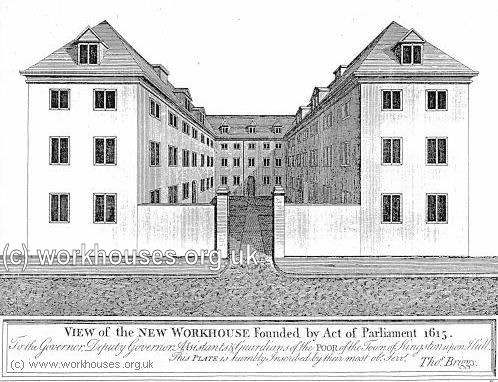 Hull workhouse, 1789.
Hull workhouse, 1789.
The institution was, as far as possible, a workhouse, there being two oakum rooms, besides wards set apart for spinning. The chief spinning-room had within it at the end of last century 38 ordinary wheels, besides six line wheels, and 72 various reels. Then there was what was called the bump-room, with 22 spinning wheels, and an equal number of reels. There were also wheels in various parts of the establishment, there being two in certain bedrooms in the women's ward, one in the sickroom, and nine in a chamber over the cells at the end of the workhouse yard, which was the home of the unfortunate women. The sickroom had within it not only a spinning wheel, but a birdcage, the two articles being there possibly to give a more cheerful and comforting appearance. All the rooms were sparsely and roughly furnished, although a good many of the beds contained feathers, the majority, however, being flocks. The quarters of the master, matron, and spinning master contained some amount of furniture in leather and mahogany, with bedsteads and hangings, the matron's room being described as containing "four-pole bedstead and blue and white hangings, corner cupboard, &c." But the workhouse officials, truthfully or otherwise, are always reputed to have the cosiest and best of the establishment, and surroundings suitable to their station and authority.
As to the rules and management of the house, every inmate who was able had to be constantly employed, half an hour being allowed for breakfast and an hour for dinner to those who did the work appointed them. The work bell rang at five o'clock in the morning and at five at night from March 1st to October 1st, and in the winter months the hours were 7 a.m. to 6 p.m. And it was the duty of the mistress to see that all lights were out and the inmates in bed by nine O'clock in. summer and eight o'clock in winter. Every Sunday the inmates had to parade for church, accompanied by the master and the spinning master, and there was a rule that "none of the poor shall be suffered to loiter in the streets under any pretence whatever in going to or returning from church." Others attended divine service according to their modes of worship. But this was not the only religious care bestowed upon the inmates, for on Thursday afternoons The master and mistress and all the servants and paupers in the house (except the sick.) Shall assemble in the dining hall to be instructed, by one of the clergymen of the town in the doctrines and duties of Christianity.
The dining-hall it may mentioned, was furnished with a fixed pulpit and desk and after all meals and from the pulpit or desk. he had to read prayers every morning before breakfast and every evening before supper, "and every person in the house shall be required to attend and of those who absent themselves unnecessarily shall be laid before the Guardians at the next meeting" And whilst, as already stated, beer was part of the bill in the house three nights a week there was a hostile opinion as to spiritous liquor, as one rule required that- The master shall not suffer any person to drink any strong liquors in the house on any pretence whatsoever unless in cases of necessity and by the advice of the surgeon. And this distinction between beer and strong drink is shown in a pamphlet issued from the Charity Hall on June 3rd 1799 giving the names and addresses of the paupers and the amounts allowed them the list having the following preface:—
There is reason the fear that much of the money which is paid out of the workhouse is spent in spiritous liquors and in other ways alike destructive of industry and morality and it is requested of the inhabitants of the town that such information of the characters of the persons mentioned in this list may be given to Mr. Chandler, the clerk of the workhouse as may enable the Governor and Guardians to discriminate between, the idle and the industrious and between those who are entitled by real indigence to receive parochial relief and those who by false pretences of poverty defraud the town. It is hoped that the weekly pensions may be greatly reduced at this season of the year without the least injury to the industrious honest poor as in general the expenses of living are much less, and work is much more abundant, in summer than in winter.
The weekly pensioners numbered 627 costing about 1s.3d. a head, or a total of £39.11s. and whether the publication of the paupers list led to the exposure of "fraud" is not stated . In addition to these 627 adults there were 109 children nearly all classed as illegitimate at nurse in the town and neighborhood. From the addresses given the poor seemed pretty well scattered throughout the parish. Amongst the residences were the following old names of streets and localities —Mill Hill, Story Close , Without Beverley Gates , Posterngate Walls, Hessle Gate Walls, Fish Shamble alley, Cockpit-yard, Without North Gate, Fore Ropery, Weavers' Hospital, Butcroft, Robert-street, Milk-street, Butchery, Without Myton Gates, and Low Church-Alley.
There were many rules for the management of the indoor paupers and for the keeping of good order. One was that:— If any person in the house shall curse or swear or be in liquor, he shall be immediately confined in the stocks for any time not exceeding four hours.
And other offenders were admonished or confined according to the magnitude of their offences, and the Guardians as to their next meeting could punish such inmates by distinction of dress, abatement of diet, loss of gratuity, or by ordering task work. Another rule reads as under:— The children shall not take God's name in vain or use any profane language. Those who shall be guilty of such crimes shall stand on a stool in the dining-hall during the times of dinner, with the crime written in large letters on a paper, which shall be pinned on their breasts and they shall only have bread and water that day. Such as are convicted of lying shall stand in like manner, with the words "Infamous Liar" on their breasts.
Other rules read to the effect that the keys of the apartments at the bottom of the workhouse yard (now part of the police station premises), where the women of the town and other idle and disorderly people were confined to work, be delivered to the master or matron every evening at seven o'clock. In other respects, certain single women coming to the house through their own misconduct had their names entered in a book, had meat rations stopped and had to wear coarse yellow coats or gowns, or other disgraceful distinctions, at the discretion of the Guardians. And other women coming to the house a second time for medical aid had to stand in the pillory in the workhouse yard for an hour at least and then be confined in one of the small rooms at the bottom of the yard.
A further local Act in 1824 (5 Geo.IV. c13) provided for "repairing or rebuilding the workhouse".
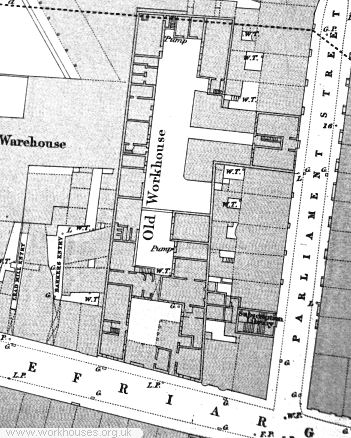
Hull Charity Hall workhouse site, 1853.
After 1834
Because of its status as a Local Act Incorporation, Hull was largely immune from the provisions of the 1834 Poor Law Amendment Act. The parishes surrounding Hull did fall in with the new Act and formed into the Sculcoates Poor Law Union.
The Incorporation continued using the Charity Hall workhouse despite pressures from the Poor Law Commissioners to erect a new building that conformed to the standards required by the 1834 Act. However, a report by the Medical Society in 1847 severely criticised conditions in the workhouse. Inmates in the workhouse complained about the poor quality of the bread and that tea was brewed in a large copper which was then ladled out like soup. In September 1847, a heavily pregnant woman was brutally assaulted while being interviewed in the workhouse Vagrants' Office and giving birth shortly afterwards. Then, in 1850, there was another scandal involving a pregnant woman being refused admission to the workhouse and promptly giving birth on the workhouse steps. The Guardians finally gave in and, in 1851, work began on a new building for 600 inmates on a 6.5 acre site at the north side of Anlaby Road at its junction with Argyle Street. The opening ceremony took place on 30th June 1852 after about 280 paupers were transferred from the old building. To celebrate the move, the inmates were given a dinner of roast beef, mutton, plum pudding, tea and spice cake.
The total cost of the new workhouse was reported to amount to £15,000 of which the construction cost was £9,461.10s. However, a significant part of the cost was met by the £7,250 proceeds from the sale of the old Charity Hall. The new building was designed by Henry F Lockwood and William Mawson who were the architects of a number of northern workhouses including those at Barnsley, Bradford, Carlisle, Dewsbury, Haslingden, North Bierley, and Penistone.
The new workhouse was constructed in an Italianate style and comprised entrance buildings with offices and casual wards, and a main block containing the Master's office, male and female accommodation wards, 550-seat dining-hall, kitchen, workrooms and school. To the rear were dining-hall, 400-seat chapel, and an infirmary. The workhouse location and layout are shown on the 1854 map below:
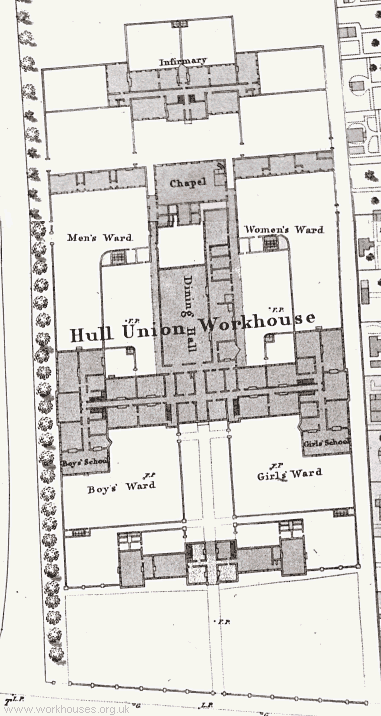
Hull Anlaby Road workhouse site, 1854.
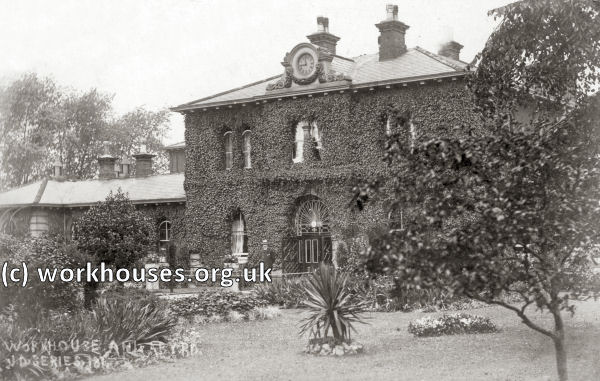
Hull workhouse entrance block from the south-east, c.1904.
© Peter Higginbotham.
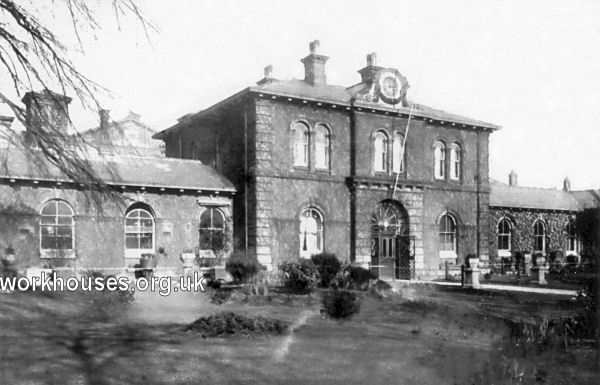
Hull workhouse entrance block from the south-west, c.1915.
In 1864, a local newspaper gave its readers a virtual tour of the institution. The entrance block at the front contained the guardians' boardroom. At the left of the entrance was the relieving office for the west district of Hull. The block also contained probationary wards for new arrivals and a room for storing their own clothes. To the rear, a path bordered by lawns led to the main block, adjacent to whose entrance was the master's office. The ground-floor accommodation on the male side, to the west, included day room, lavatories (washrooms), a bedroom for infirm men, and the boys' schoolroom. A boys' drum and fife band had been started. The upper floor contained dormitories for the boys and able-bodied men. The women's side mirrored that of the men's. The dining-hall, at bthe centre rear, could seat up to 550 diners. Kitchens were locatd at its east side. The workhouse baked bread for its own inmates and also that supplied by the relieving-officers to those parties who were entitled to out-door relief. The chapel, at the rear of the dining-hall hall wasconnected to the main building by a covered way on each side, The infirmary stood at the north of the site, with a separate mortuary.
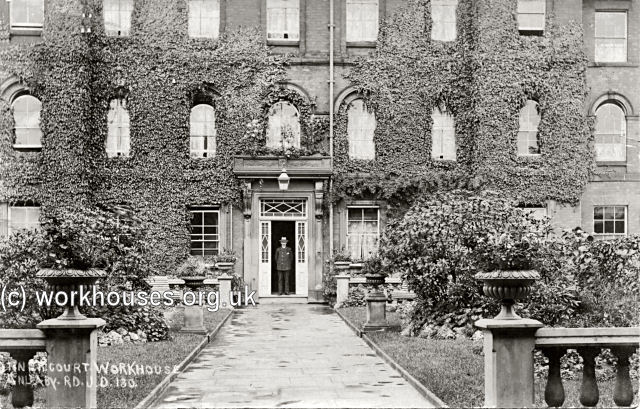
Hull workhouse main block, c.1904.
© Peter Higginbotham.
In 1892, a new hospital was erected which became known as the East Hospital. The sum of £5,800 was authorised for its construction.
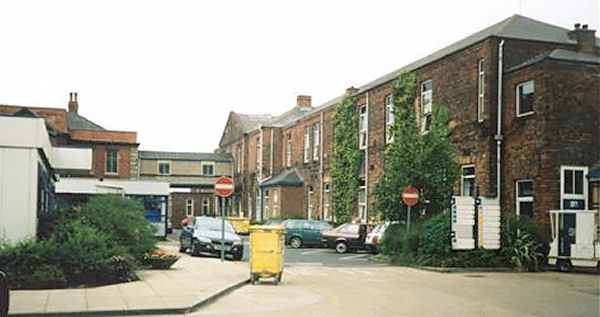
Hull East Hospital from the south, 2001.
© Robert Jennings.
In 1912, £16,125 was authorized for a 240-bed hospital to be built parallel to Argyle Street. The four-storey building, which was completed in 1914, was known as the Naval Hospital or West Hospital.
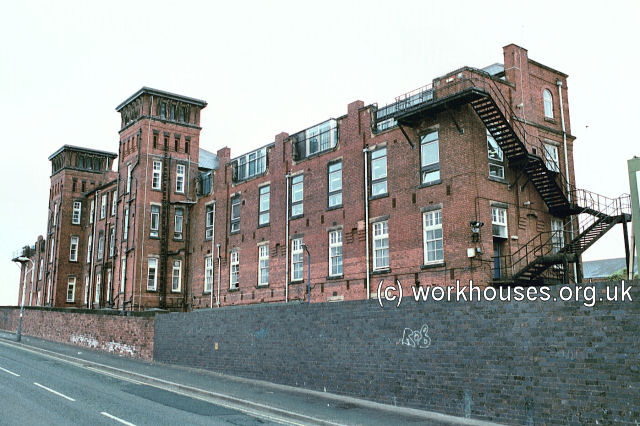
Hull West Hospital from the south-west, 2001.
© Peter Higginbotham.
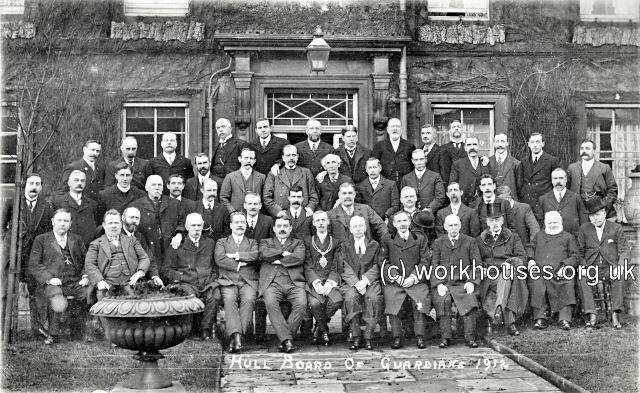
Hull Board of Guardians, 1912.
© Peter Higginbotham.
The Brabazon Scheme, initiated in 1880 by Lady Brabazon, was intended to provide interesting and useful occupation such as knitting, embroidery or lace-making, for non-able-bodied workhouse inmates who spent long hours confined to bed or in day rooms. Training in the various crafts was provided by outside volunteers. The work produced under the scheme, which as often of very high quality, was sometimes sold to the public and the proceeds used to provide recreation for elderly and bedridden inmates. The picture below shows items on offer at a Brabazon scheme sale at Hull workhouse in 1905.
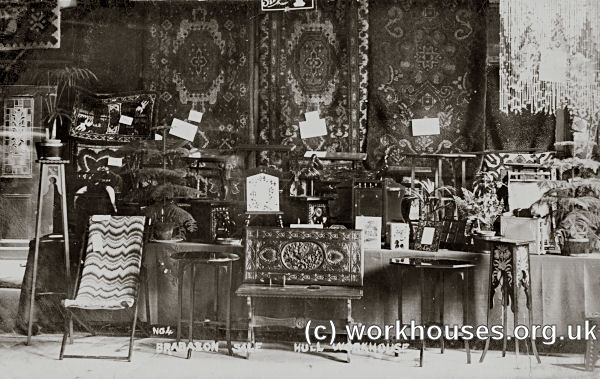
Brabazon scheme sale at Hull workhouse, 1905.
© Peter Higginbotham.
From 1904, to protect them from disadvantage in later life, the birth certificates for those born in the workhouse gave its address just as 188 Anlaby Road, Hull.
In 1931, the workhouse was taken over by Hull Council. In 1931, the casual wards were closed down with Sculcoates taking over this role.
In 1948, the site became an NHS hospital known as the Western General. In 1966, the site was taken over by the Hull Royal Infirmary, formerly based on Prescott Street, and a large tower block constructed. All the former workhouse buildings have now been demolished.
The Charity Hall site is now fronted by the HMV and New Look shops.
Scattered Homes
Hull opened a number of children's scattered homes around the city for the accommodation of pauper children in its care. The locations over the years included: 121 Coltman Street, 37 Derringham Street; 11, 30 & 58 Cholmley Street; 34 Fountain Street; 23, 92 & 113 Linnaeus Street; 58 and 64 Mayfield Street. Most of the homes housed ten children. There was also a Receiving Home at 16-18 Linnaeus Street for new children coming into the homes system.
Staff
Inmates
Records
Note: many repositories impose a closure period of up to 100 years for records identifying individuals. Before travelling a long distance, always check that the records you want to consult will be available.
- Hull City Archives, Hull History Centre, Worship Street, Hull HU2 8BG. Holdings include: minute books (1698-1750, 1907-30); Admissions and discharges (1729-59, 1842-8); Register of parish apprentices (1802-44); etc.
Bibliography
- Hull's Workhouses by Anthony Chadwick (Ripon Museum Trust leaflet, 1996)
- Fallowfield, M & Watson, I (1985) The New Poor Law in Humberside (Humberside College of Higher Education)
- National Conference of Friendly Societies Souvenir Handbook (1915).
Links
- A Walk through Hull Workhouse — an 1864 newspaper description of the institution.
- Ripon Workhouse Museum
Acknowledgments
- The help of Robert Jennings in compiling this page is acknowledged.
Unless otherwise indicated, this page () is copyright Peter Higginbotham. Contents may not be reproduced without permission.


